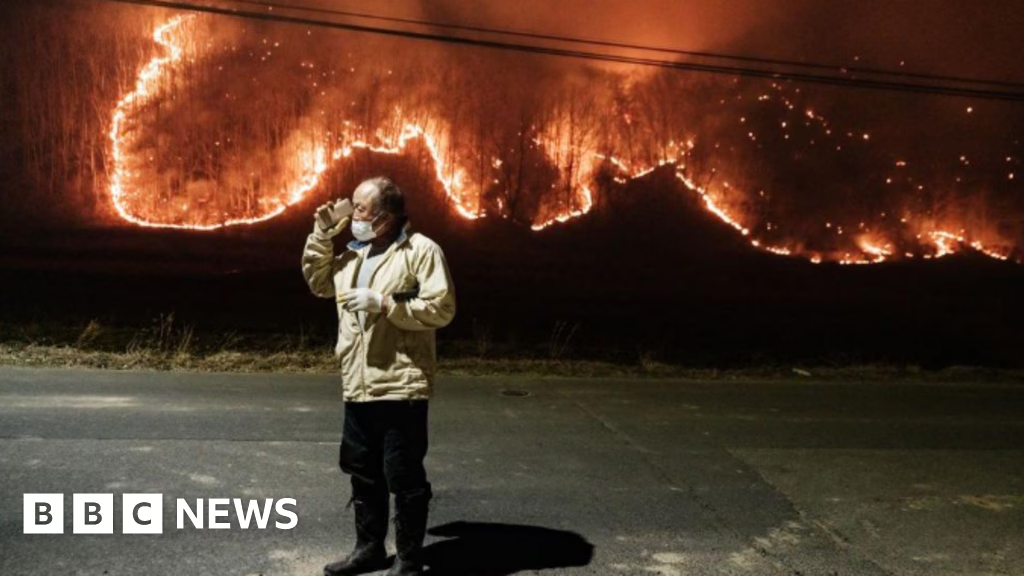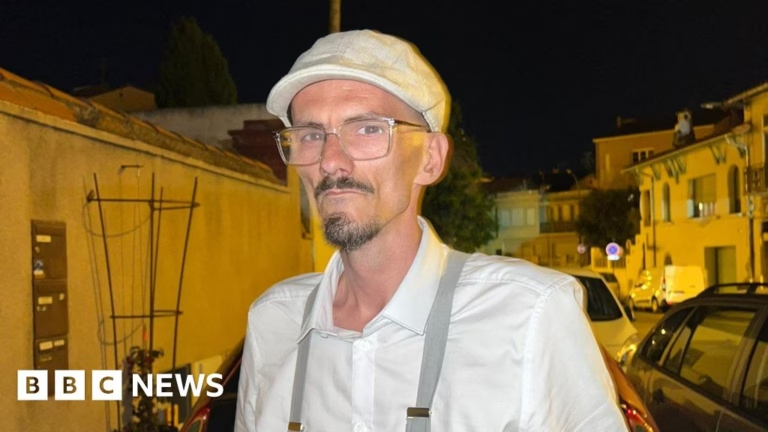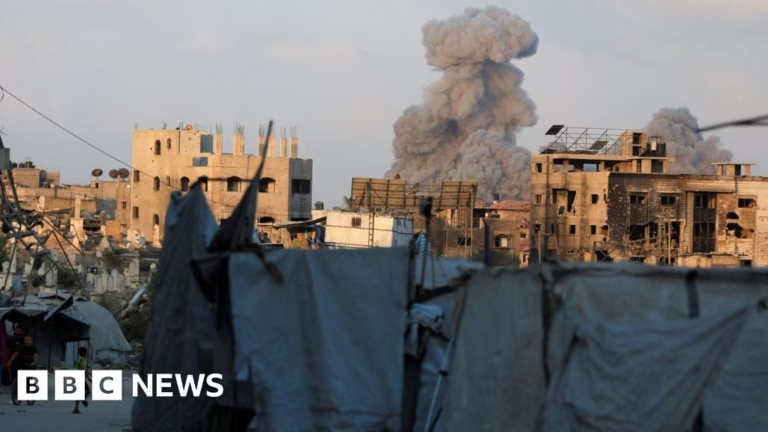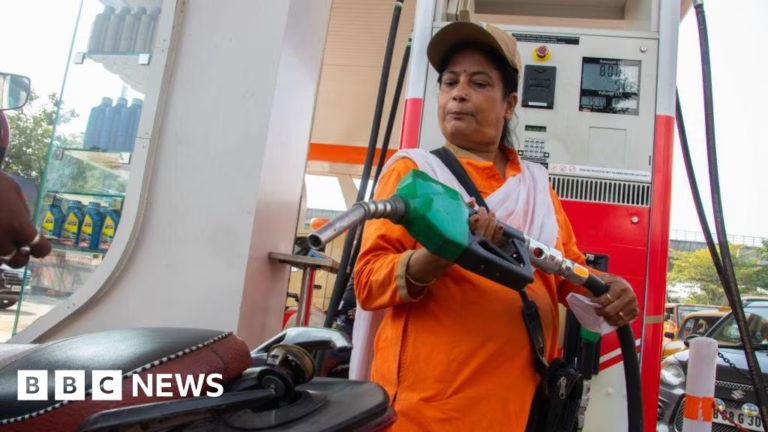<div id=""
<
blockquote>
 Getty Images
Getty ImagesStrong winds, dense forest and unusually dry weather – that’s the deadly combination that experts say is fuelling the largest wildfires in South Korea’s history.
The inferno in the south-east has burned through 35,810 hectares (88,500 acres) as of Thursday – that’s about half the size of New York City – killing 27 people so far and displacing tens of thousands.
Authorities believe the wildfires started by accident from human activity, but the main drivers of the devastation are dry land, and strong gusts sweeping over inland regions.
The high concentration of pine forest in North Gyeongsang province, where the fires are burning, is also “oiling” the blaze, said a forest disaster expert.
Vulnerable pine forests
“Pine trees contain resin, which acts like oil, intensifying fires when ignited. This resin causes wildfires to burn faster, stronger, and longer,” said Lee Byung-doo from the National Institute of Forest Science in Seoul.

Andong, one of the worst-hit cities, is known for its tranquil pine forests.
While they provide shelter and food for local wildlife and sometimes help break the wind, pine trees “become problematic during wildfires”, Mr Lee told the BBC.
“Because forests [in South Korea] contain large numbers of pine trees, the areas are particularly vulnerable when fires break out,” he said.
Furthermore, pine trees retain their needles throughout winter, making them susceptible to “crown fires” – wildfires that spread by igniting the dense canopy of branches and leaves. This has contributed to the rapid and extensive spread of the flames over the past week.
<
div data-component=”image-block” class=”sc-18fde0d6-0 jFCfG”>
<
div data-testid=”image” class=”sc-a34861b-1 jxzoZC”><img sizes=”(min-width: 1280px) 50vw, (min-width: 1008px) 66vw, 96vw” srcset=”https://ichef.bbci.co.uk/news/240/cpsprodpb(334a)(live)(b9d239c0-0af2-11f0-bf59-3b6bbdd820ea)(6fe8)(live)(80cbfd50-0aeb-11f0bf59-3b6bbdd820ea)(6fe8)(live)(80cbfd50-0aeb-11f0bf59-3b6bbdd820ea)(80cbfd50-0aeb-11f0bf59-3b6bbdd820ea)(6fe8)(live)(80cbfd50-0aeb-11f0bf59-3b6bbdd820ea)(6fe8)(live)(80cbfd50-0aeb-11f0bf59-3b6bbdd820ea)(80cbfd50-0aeb-11f0bf59-3b6bbdd820ea)(6fe8)(live)(80cbfd50-0aeb-11f0bf59-3b6bbdd820ea)(6fe8)(live)(80cbfd50-0aeb-11f0bf59-3b6bbdd820ea)(6fe8)(live)(80cbfd50-0aeb-11f0bf59-3b6bbdd820ea)(80cbfd50-0aeb-11f0bf59-3b6bbdd820ea)(6fe8)(live)(80cbfd50-0aeb-11f0bf59-3b6bbdd820ea)(6fe8)(live)(80cbfd50-0aeb-11f0bf59-3b6bbdd820ea)(6fe8)(live)(80cbfd50-0aeb-11f0bf59-3b6bbdd820ea)(6fe8)(live)(6fe8)(live)(80cbfd50-0aeb-11f0bf59-3b6bbdd820ea)(6fe8)(live)(6fe8)(live)(80cbfd50-0aeb-11f0bf59-3b6bbdd820ea)(6fe8)(live)(80cbfd50-0aeb-11f0bf59-3b6bbdd820ea)(80cbfd50-0aeb-11f0bf59-3b6bbdd820ea)(6fe8)(live)(6fe8ln)(live)(6fe8ln)(live)(6fe8ln)(live) 240w,https://ichef.bbci.co.uk/news/320/cpsprodpb(334a)(live)(b9d239c0-0af2-11f0bf59-3b6bbdd820ea)(6fe8)(live)(80cbfd50-0aeb-11f0bf59-3b6bbdd820ea)(6fe8)(live)(80cbfd50-0aeb-11f0bf59-3b6bbdd820ea)(6fe8)(live)(6fe8ln)(live)(6fe8ln)(live)(80cbfd50-0aeb-11f0bf59-3b6bbdd820ea)(6fe8)(live)(80cbfd50-0aeb-11f0bf59-3b6bbdd820ea)(6fe8)(live)(6fe8)(live)(6fe8ln)(live)(6fe81n)(live)(6fe8)(live)(80cbfd50-0aeb-11f0bf59-3b6bbdd820ea)(6fe8)(live)(6fe8ln)(live)(6fe8ln)(live)(6fe8ln)(live)(80cbfd50-0aeb-11f0bf59-3b6bbdd820ea)(6fe8)(live)(80cbfd50-0aeb-11f0bf59-3b6bbdd820ea)(6fe8)(live)(6fe8)(live)(6fe8ln)(live)(6fe8ln)(live)(6fe8)(live)(6fe8ln)(live)(6fe8ln)(live)(80cbfd50-0aeb-11f0bf59-3b6bbdd820ea)(6fe8)(live)(6fe8ln)(live)(6fe8ln)(live)(6fe81n)(live)(6fe8)(live)(6fe81n)(live)(80cbfd50-0aeb-11f0bf59-3b6bbdd820ea)(6fe8)(live)(6fe8ln)(live)(6fe81n)(live)(6fe8)(live)(6fe8ln)(live)(6fe8ln)(live)(6fe8)(live)(6fe81n)(live)(80cbfd50-0aeb-11f0bf59-3b6bbdd820ea)(6fe8)(live)(6fe8ln)(live)(6fe8ln)(live)(6fe8)(live)(6fe81n)(live)(80cbfd50-0aeb-11f0bf59-3b6bbdd820ea)(6fe8)](live)(6fe81n)(live)(6fe8)(live)(6fe8ln)(live)(6fe81n)(live)(80cbfd50-0aeb-11f0bf59-3b6bbdd820ea)(6fe8)(live)(6fe8ln)(live)(6fe8ln)(live)(6fe8)(live)(6fe81n)(live)(80cbfd50-0aeb-11f0bf59-3b6bbdd820ea)(6fe8)(live)(—80cbfd50-0aeb-11f0bf59-3b6bbdd820ea)(1536w)(807w)(140w)(70w)(30w)”,” alt=”Getty Images A cracked bell at Goun Temple in the North Gyeongsang, where many other structures have been burned to the ground”








